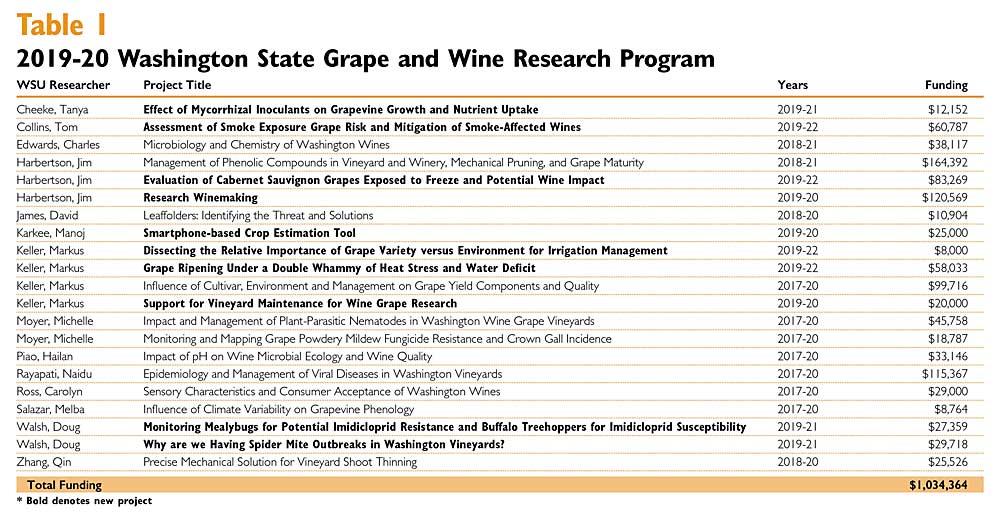Wine research in Washington state continues to move forward. The Washington State Wine Commission recently allocated $1,034,364 for viticulture and enology research for fiscal year 2020 (July through June). This is the third consecutive year research funding has exceeded the $1 million mark, thanks to the strong support of the Washington wine industry and the Auction of Washington Wines.
Viticulture and enology research is funded through the Washington State Grape and Wine Research Program, a competitive grant program administered by Washington State University. This year, the program will fund 21 research projects (see Table 1). Although funded projects cover a diversity of vineyard and winery challenges, the ultimate goal of research is to improve grape and wine quality.
Vineyard projects for 2019-20 range from learning about a new grape leaffolder moth that has defoliated some Washington grapevines, to developing integrated and sustainable strategies for pests and diseases, to fine-tuning irrigation management and more. Winery research projects focus on better understanding smoke exposure on grapes, managing tannins in the winemaking process, controlling wine spoilage, dealing with high-pH fruit and more.
Financial support for the statewide research program — with its public, private and industry sources — is unlike any other wine research program in the nation. The program is industry-driven and benefits all growers and wineries in the state; projects are funded based on recommendations by the Wine Research Advisory Committee and approval of the Washington State Wine Commission board of commissioners. The Wine Research Advisory Committee, a subcommittee of the Wine Commission composed of growers and winemakers, serves as the scientific review arm of the industry.
Of the approximately $1,034,000 in grants awarded for 2019-20, the Auction of Washington Wines funded projects worth $280,725; the Washington Wine Commission provided $239,184; Washington State University provided $214,455; and $300,000 came from state taxes (1/4 cent per liter) collected on all wines sold.

New projects
Ten new research projects were added this year. Projects are typically three years in duration. If, at the end of the three years, additional work on a subject is needed, a new proposal with new objectives is submitted and evaluated as a new project.
New research topics include:
—Mechanization: Develop a smartphone application to help growers estimate crop load. (This project received seed money last year to learn if the app was feasible.)
—Soil sustainability: Optimize the impact of mycorrhizal fungi inoculations (beneficial soilborne microorganisms) on wine grape production and learn if commercially available mycorrhizal inoculants are effective in Washington vineyards.
—Irrigation management (two projects): 1) Help growers optimize canopy management and irrigation practices for different varieties to mitigate decrease of acidity in wines from heat waves. 2) Compare varietal irrigation behavior to learn if differences are driven by genotype (variety) or environment (site and growing season), which will then help develop variety and site-specific irrigation management strategies.
—Smoke exposure: Develop analytical methods to measure compounds in smoke-exposed fruit, learn what levels in fruit result in smoke-tainted wine and develop strategies to mitigate smoke taint in wine. (The first three years of study developed a portable smokehouse and examined fuel sources and timing.)
—Freeze exposure: Identify the causal agents of atypical aromas in Cabernet Sauvignon wines made from grapes exposed to freezing temperatures before harvest and investigate ways to mitigate potential problems.
—Virus vector resistance/susceptibility to imidacloprid: Learn if grape mealybug (an insect that transmits grapevine leafroll disease) is developing resistance to the insecticide imidacloprid and if buffalo treehopper (a possible vector of grapevine red blotch disease) is susceptible to imidacloprid.
—Spider mites: Identify why spider mite outbreaks are becoming increasingly common and learn if imidacloprid, a widely used insecticide to control the vector of grapevine leafroll disease, has influence on spider mite and predatory mite populations.
The Wine Research Advisory Committee is led by Rick Hamman. Other industry volunteer members include Leah Adint, Dick Boushey, Brian Carter, Kevin Corliss, Julia Kock, Linn Scott, Kay Simon, Russ Smithyman, Bruce Watson, Scott Williams and Wade Wolfe.
To learn more about research for the Washington wine industry and access previous research reports, visit washingtonwine.org/research/reports. •
—by Melissa Hansen






Leave A Comment